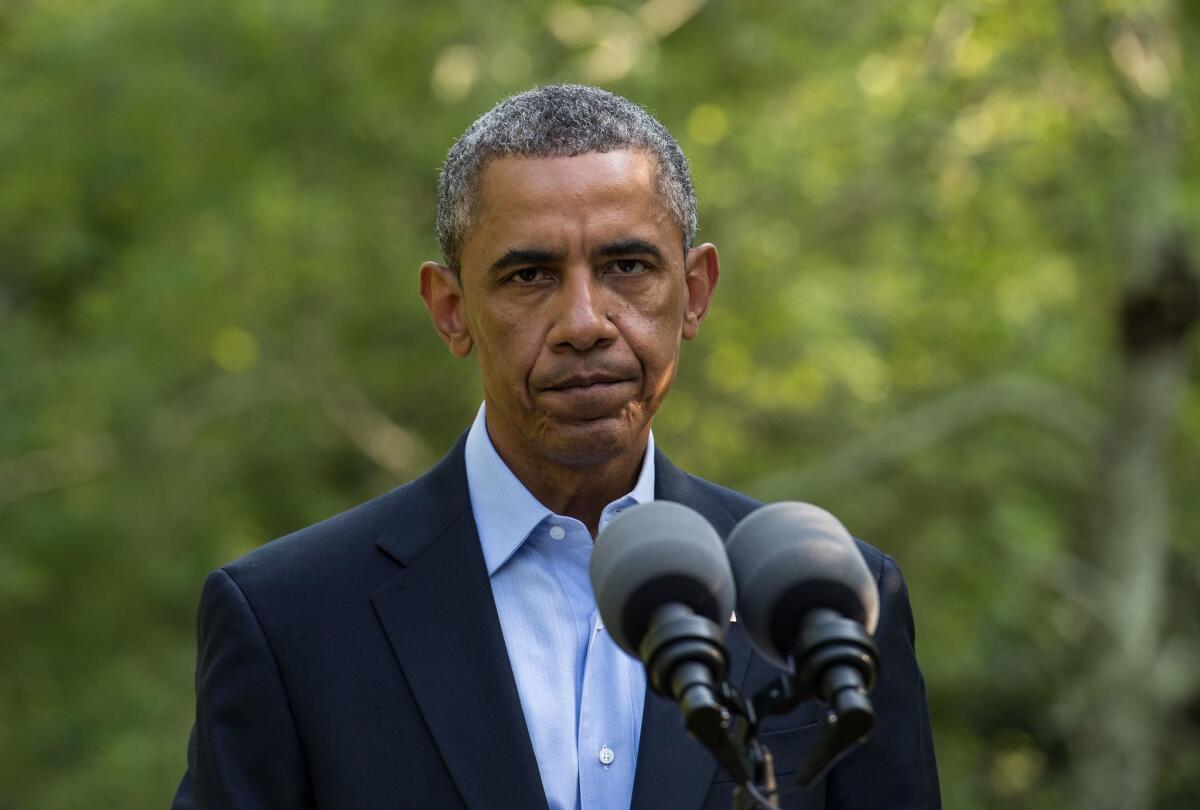Op-Ed: Pivoting away from Asia

What do President Obama’s decision to authorize airstrikes against the Sunni militants of the Islamic State and his previous commitment to send American military advisors and trainers back into Iraq have to do with his “pivot” to Asia? Everything and nothing.
Nothing in the sense that the battle in Iraq has little bearing today on what China might do in the South China Sea tomorrow. But everything in the sense that the underlying assumption that drove Obama to pivot away from the Middle East toward Asia — to “rebalance,” as it was later called — is very much in question.
When the rebalance toward Asia was officially confirmed as administration policy in January 2012 by the Pentagon’s release of a new strategic policy guidance, the underlying impetus was clear: Defense resources could no longer support the long-standing U.S. strategy of maintaining the capability to fight two major conflicts at the same time — the “two-war standard.” With no apparent political prospects for closing the gap in military resources, the administration made a strategic decision to stabilize an increasingly problematic situation in Asia.
The logic for paying more attention to Asia was apparent. The region was seen as a key area of expansion for the American economy. Politically, it was home to populous liberal democracies, India and Indonesia; a newly vibrant South Korea; and long-standing friends and allies, like Taiwan and Japan.
It was also home, of course, to a rising China. Initially, the Obama team had hoped to create a new dynamic with Beijing. Putting aside tension-inducing concerns such as China’s human rights record, the plan was to develop a virtual smorgasbord of agenda items that would reflect overlapping interests between the two countries. The administration was doubling down on a policy of engagement.
As Obama discovered when the Chinese delegation upended his efforts to salvage the 2009 Copenhagen climate change summit, overlapping interests are not the same thing as having the same priorities. China’s leaders were undoubtedly concerned about the country’s environmental problems, but their more pressing concern was making sure that the country continues to grow economically. More stringent carbon emission standards were, they believed, at odds with that more immediate need.
As the Obama team also discovered, its attempts to engage more deeply with Beijing were complicated by the government’s reaction. Beijing read these efforts as an implicit signal that a war-weary and recession-ridden Washington was scrambling to make the best of its declining global position. Instead of accepting the administration’s offer of a new “G-2” condominium, China’s ambitions seemed to grow — not recede — as it continued a military buildup and became even more assertive with neighboring states.
It was principally this deteriorating state of affairs that the administration rightly wanted to address with the rebalance.
It also coincided with the administration’s perspective that continuing to draw down military forces in Europe was reasonable in the absence of any perceived security problem facing the continent. It also squared with the president’s own determination to end, as much as possible, military involvement in the Middle East and North Africa. Two-war capability isn’t needed if your focus is really on only half the globe.
But this does not take into account a key strategic reason for maintaining two-war capability. According to the 1997 Quadrennial Defense Review, a four-year military policy and spending plan, having “a core capability is central … to avoiding a situation in which an aggressor in one region might be tempted to take advantage when U.S. forces are heavily engaged elsewhere.” This broader military capacity also allows, the Clinton Pentagon argued, for “continued engagement in shaping the international environment to reduce the chances that such threats will develop in the first place.”
In other words, power does abhor a vacuum. If the United States is not there to deter, would-be aggressors will probably take advantage.
Isn’t this the situation the country faces today? As the administration pivoted away from Europe and the Middle East, our adversaries — be they Russia, Iran or the jihadists — have become emboldened and more than willing to fill the vacuum we have left.
Ironically, the Obama team harshly criticized the previous administration for foreign policies it viewed as off target — they accused the Bush administration of spending too much time focused on the wars in Iraq and Afghanistan and far too little on American diplomatic, economic and security interests in Asia. Yet today the very hot spots that are consuming the current administration’s attention and dominating Secretary of State John F. Kerry’s travel schedule are precisely those areas the Obama White House has wanted to disengage from militarily.
Without question, giving greater attention to Asia is called for, but if it comes at the expense of other key parts of the globe, it probably will be counterproductive. As the president is discovering, America’s resources and attention will continue to be drawn back into those areas as the security situation worsens.
A true rebalancing is neither possible, given the state of today’s U.S. military, nor likely to be sustainable if planned defense cuts are not reversed. The reality is that the United States cannot rebalance on the cheap.
Gary Schmitt is director of the Marilyn Ware Center for Security Studies at the American Enterprise Institute.
Follow the Opinion section on Twitter @latimesopinion
More to Read
A cure for the common opinion
Get thought-provoking perspectives with our weekly newsletter.
You may occasionally receive promotional content from the Los Angeles Times.





